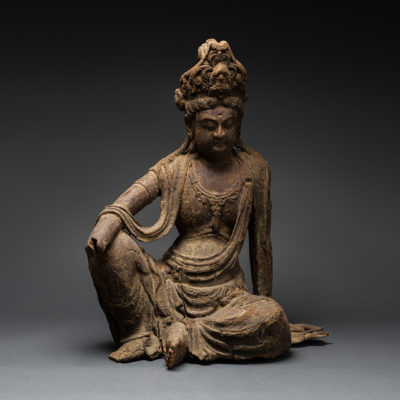
| SKU | RD.031 |
|---|---|
| Circa | 1500 AD to 1700 AD |
| Medium | Wood |
| Origin | China |
| Gallery Location | S Korea |
The fundamental tenet of Buddhism is that salvation is possible to all sentient beings because they possess the Buddha nature in them and hence all can potentially be enlightened. Enlightenment is simply achieved by faith and devotion to Buddha and the religious ideal, represented by the Bodhisattva Pratyekabuddha (Pizhifo) or Arhat (Aluohan/Luohan), among others. These beings, though qualified to enter nirvana, delay their final entry in order to bring every sentient being across the sea of misery to the calm shores of enlightenment. The Bodhisattva Avalokitesvara (Guanyin Pusa) is the Buddhist deity of compassion and mercy.
The late part of the M’ing Dynasty saw an increased emphasis upon Confucianism, combined with strong martial elements oriented towards defence – the Great Wall dates mainly from this period. When the ultra-conservative Manchus (from Manchuria, north east of China) took over in 1644 and founded the Q’ing dynasty, they set in motion a series of changes that utterly altered the face of China, including insistence upon the Emperor as a divine being, and a strongly separatist attitude towards the outside world. Paradoxically, the arts flowered during this period, although it has been suggested that the stylistic conventions engendered during this period remained essentially unchanged until the end of the imperial dynastic system with the hapless Pu-Yi (deposed in 1912). This figure, which dates to near the transition of the dynasties (17th century AD) therefore pertains to a highly dynamic and socially restive time, peculiarly at odds with the serene appearance of the figure’s face.
This Bodhisattva is seated in padmasanam (lotus position) with one hand resting in the lap and the other raised in a gesture of reflective benediction. The Bodhisattva’s worldly ornaments – such as the high tiara and rich necklaces in sumptuous detail – contrast with the plainer image of the Buddha, whose minimal markings indicate his earthy purity. The lower half of the body is clad in a loose tunic-like garment tied at the waist with an ornate knot, overlain by a set of long robes carved with extreme attention to detail and with a great sense of movement. The face is framed by long curls of hair protruding from beneath the ornate tiara, and by long earlobes. The whole is ornamented yet further with a long, complex necklace that hangs down to the mid chest area. The face is naturalistic and well-nourished in general demeanour, with sensitively carved eye, nose and mouth. The texture and patina of the wood is superb. This is a beautifully made and well-preserved sculpture, dating from a dynamic and exciting period in China’s history. It would be a major and important addition to any serious collection, but would look superb in any setting into which it was placed.
Login to view price
Sign-up to receive the latest Wedding Estates news and promotions!

